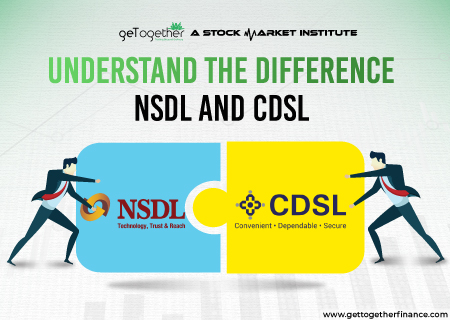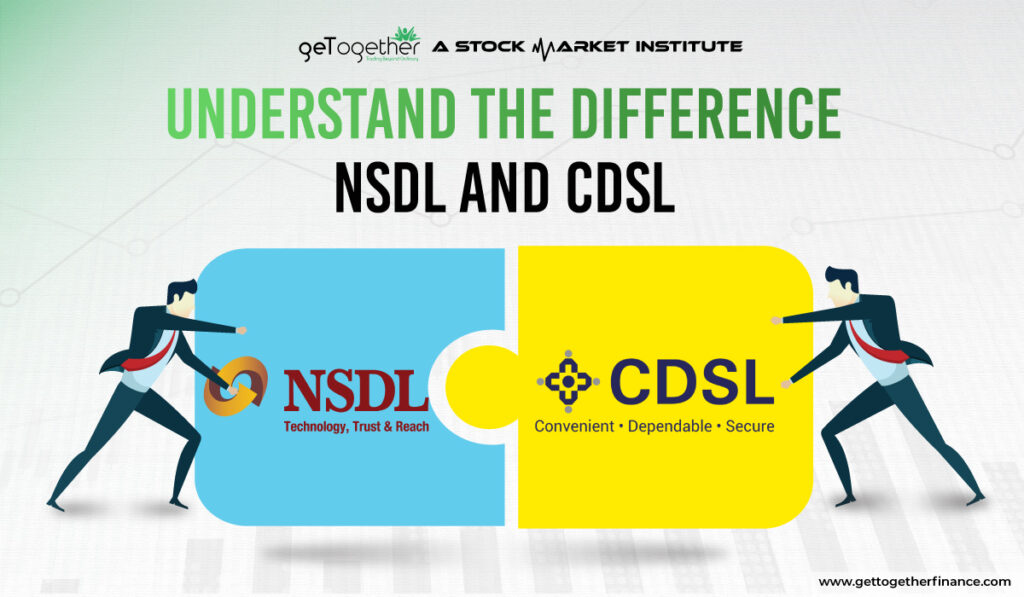NSDL and CDSL: Understand the difference
- November 6, 2024
- 793 Views
- by Manaswi Agarwal


In the initial stage of the financial market, terms like NSDL and CDSL might sound new which hold a great significance in the working of financial securities. But what exactly does it mean?
In India, buying and selling of shares is possible just because of share depositories as they function to hold the financial securities like shares and bonds. Read this brief overview about both the depositories to understand how they have revolutionized securities trading and dematerialization to shape the world of modern investing.
What is NSDL?

NSDL or National Securities Depository Limited as the name suggests is a depository of Indian financial securities which offers the depository services to investors, issuers or intermediaries. The depository was founded in 1996 to keep the trading assets in electronic form securely. It is the primary security repository in India.
What is CDSL?

CDSL or Central Depository Services Limited offers depository services in the Indian financial market which was founded in 1999. CDSL offers services of dematerialization and rematerialisation and the operations of the depositories are operated by SEBI.
Also Read: NSE
CDSL Vs NSDL

Depositories have to play a crucial role in the financial system to manage and settle the securities. Once you start buying or selling your shares, the transactions are debited or credited from the depository and then reflected into the Demat accounts of shareholders. Both the depositories make trading convenient by providing necessary information about the listed companies to the investors about dividend rights, stock splits, etc. However, both of them differs from each in some or the other way, let us discuss the differences below:
Ownership
CDSL was primarily owned by the Bombay Stock Exchange or BSE. While the other one was primarily promoted by NSE.
Incorporation
CDSL was incorporated in 1999 as the second depository in India dominating in terms of retail investors having numerous individual demat accounts. On the other hand, NSDL was the first depository in India which was established in 1996 initially having a stronger presence with institutional investors but gradually it has increased its base of retail investors.
Demat Account Number
Demat accounts under CDSL have 16 numeric digits in them while demat accounts with national depository contain 14 numeric digits which eventually start with letter ‘IN’.
Investor Accounts
According to the recent reports, NSDL is the largest depository in terms of investor accounts having a substantial market share of over 2.2 crores investor accounts. Also, due to its early establishment, it has strong ties with major financial institutions. On the other hand, CDSL contains 1.5 crore investor accounts, having a smaller market share as compared to national depository with a strong presence to attract Indian investors.
Stock Exchange Partners
The primary operating market for NSDL is the NSE while for CDSL, the primary operating market is BSE.
Both of them are the depositories regulated by the SEBI and offer almost similar services to the investors, issuers and intermediaries. It is quite difficult to differentiate among both the depositories but here are some of the major differences between these depositories.
| Determinants | NSDL | CDSL |
| Establishment | 1996 | 1999 |
| Purpose | NSDL as an Indian central securities repository allows electronic storing and trading of securities. | CDSL offers depository services to the Indian securities market. |
| Participants | More | Fewer |
| Operating Markets | National Stock Exchange | Bombay Stock Exchange |
| Numeric Code | 14-character numeric code | 16 digits numeric code |
Similar Functions of NSDL and CDSL

NSDL and CDSL have a lot of similarity in their functions, out which the most common ones are:
Dematerialization and Rematerialisation
Earlier, in the 90s when shares were available in offline forms, they were held in physical paper certificates and to hold the shares in electronic form, the depositories were required. The process of converting physical securities in electronic form is called dematerialization of services. And, the process of converting electronic services back to physical securities is called rematerialization and these services are offered by NSDL.
Corporate Actions
Depositories are responsible to manage and inform the corporate actions implemented on a stock or an asset. It processes the corporate actions such as dividend payment, interest payouts, stock splits and rights issues. The platform ensures that the corporate actions are processed accurately and efficiently.
The Bottom Line
NSDL and CDSL both provide depository services to the investors and operate their demat accounts for transfering of shares. There are no major differences among them except the number of participants and numeric code that they follow.
FAQs
What is NSDL?
NSDL or National Securities Depository Ltd is a government registered share depository in India which offers depository services to investors, issuers and intermediaries.
What is CDSL?
CDSL or Central Depository Services Limited provides depository services to the Indian securities market.
Can I transfer shares from NSDL to CDSL?
Yes, shares can be transferred from NSDL to CDSL or vice versa and this process of transfer is termed as an inter depository transaction or transfer.
Which is better: CDSL or NSDL?
It is difficult to figure out which depository is better CDSL or NSDL as both of them offer similar services. What matters the most are your investment decisions, returns and overall performance of the portfolio.
Who regulates CDSL and NSDL?
SEBI regulates the working of NSDL and CDSL but the operating markets for both of them are different. UTI and IDBI have a major control over national depository as they are the board of directors and on the other the major holdings of CDSL lies with BSE.



 Instagram
Instagram 
